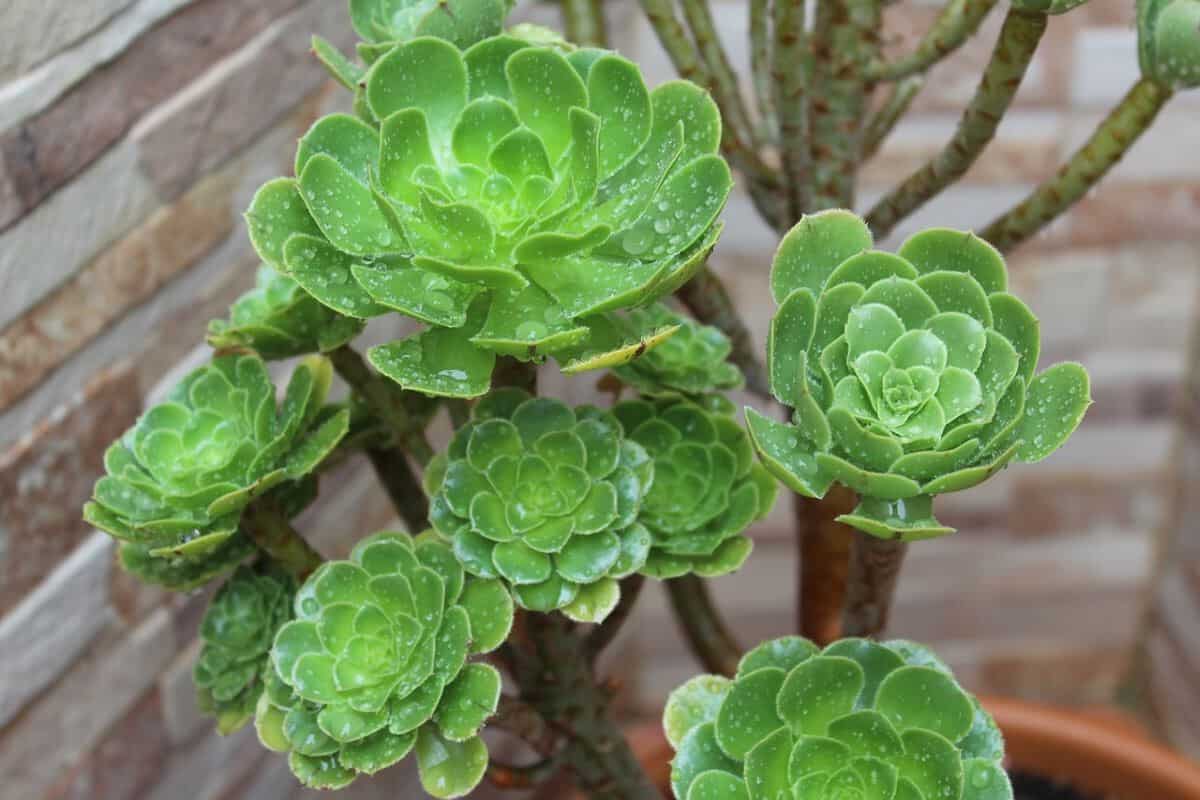America is a massive country geography-wise, and the climate varies a great deal across its length and breadth. States such as North Dakota, Maine, and Minnesota are known for their cold climate. Texas, Florida, Arizona, etc., feature among the country’s warmest regions; therefore, ideal for growing succulents.
The best succulents to grow in the warm climate conditions of Texas are Aeoniums, Senecio mandraliscae, Sempervivum, Crassula ovata, Cereus, and Echinocereus. Other succulent plant varieties you can consider include Agave, Aloe, Euphorbia tirucalli, Sedums, Opuntia, and Kalanchoe thyrsiflora.
Keep reading to learn more about these succulents and what renders them suitable to grow in Texas and states that fall in a similar climate zone.

Senecio Mandraliscae
Senecio mandraliscae, or Curio repens, is a succulent plant species native to South Africa’s Western Cape province.
Commonly referred to as blue chalk sticks or blue fingers, the plant has an ornamental look and vibe. It typically grows from crevices within rocky sandstone slopes. The succulent has bushy and sports bluish-green leaves growing up to 6 inches (15.2 cm) long. It can grow up to 18 inches (45.7 cm) tall and 24 inches (61 cm) wide at maturity.
Curio repens thrives on bright sunlight. In hot summer climates, however, the plant prefers light afternoon shade. The plant should be watered only in dry summer weather as it can withstand long, dry phases. When its built-in water sources deplete, you’ll know. In other words, the plant’s leaves will start to wilt or shrink. The plant is hardy in the plant hardiness zones 10 to 12, by the way.
If you don’t know much about hardiness zones, watch this explainer video:
Aeonium
Also known as the tree houseleeks, Aeoniums are part of the genus that comprises around 35 species of subtropical, succulent plants of the Crassulaceae family. The commercially sold Aeoniums are hybrid crosses or cultivars derived from a small group of species—including A. tabuliforme, A. haworthia, A. undulatum, and A. Arboreum.
The plant forms fleshy rosettes, bearing a striking similarity to other succulents such as Sempervivum and Echeveria. Based on the specific variety, the plant could grow low or sport multiple branches.
The plant’s leaves are slightly rounded. The stems could be stubby and short or branched and long. The leaves could sport solid hues or an amalgamation of white, red, yellow, and green.
The flowering stems originate from the rosettes’ center. The star-like, small flowers grow in constellations. The tall varieties could appear like bonsai upon getting shrubby. The cuttings easily root and form fresh plants, filling out your plant area quickly.
In warmer climates, Aeoniums could be grown as perennials in the ground and as potted or bagged plants on patios or decks. In less warm regions, they must be grown within containers and should be taken indoors before frost.
Sempervivum
Sempervivum, or houseleek, is a genus belonging to the Crassulaceae family of 40 different flowering plant species. People who prefer plants with minimal care and maintenance requirements will fancy Sempervivum a lot.
The plant’s hardy nature makes it an all-weather companion, and the beautiful rosettes help it stand out in any garden. Even if neglected, the plant can grow new plants or offsets that can be easily separated and grown as new specimens. If you have a dry, hot spot in your garden with gritty or rocky soil, you’ve got ideal Sempervivum growing conditions to boot.
The Sempervivum not just thrives in sites or regions that other plants cannot put up with, but the succulent also easily multiplies and flowers with ease in those testing conditions. It grows low and adapts to most soils. Not to mention, the plant can form rosettes in different colors.
Crassula Ovata
The Crassula ovata, also called the jade plant, is a succulent with small white or pink flowers native to the provinces of Mozambique and South Africa. However, it can be commonly grown as a houseplant in various parts of the world. The succulent plant is typically grown indoors and looks like a mini tree with branches and a trunk.
This hardy succulent plant needs two things for healthy growth: plenty of light and water. The plant can also be grown outdoors, provided there is enough sun and heat.
In Texas, growing the plant outdoors would be ideal. Besides the thick, oval-shaped leaves, the plant produces pink or white flowers when grown in ideal conditions, adding to the plant’s overall look and the surroundings it grows in.
Cereus
Cereus is a cacti genus consisting of more than 30 species of big columnar, South American cacti. Originating in Brazil, Uruguay, and Paraguay, the cactus’ night-blooming varieties are found growing in the USDA’s (United States Department of Agriculture) plant hardiness zones 9 to 11.
That is typical of the Chihuahuan and Sonoran deserts of New Mexico, Arizona, Northern Mexico, and West Texas. The plant favors sandy, quickly draining mineral soil, full sunlight, and xeric moisture levels.
There are quite a few varieties of the plant—including Cereus repandus, Cereus hexagonus, and Cereus hildmannianus. All the varieties favor similar growing environments and can be grown close to each other, and they prefer alluvial desert soil and little naturally available water.
Echinocereus
Echinocereus is a cylindrical, small-to-medium-sized cacti genus that consists of around 70 species indigenous to the rocky, sunny regions of Mexico and the southern United States.
Thanks to the curious-looking spines and big, beautiful flowers, many fancy the plant’s appearance. While certain kinds of the plant have specific requirements, others can thrive in a range of conditions.
Compared to most other succulents, the plant is predominantly short in stature. The Echinocereus genus cacti can be grown in containers and outdoors to add some visual interest to drought-tolerant landscapes, borders, and flower beds.
Echinocereus is fairly versatile too. Besides thriving in Texas-like, frost-free climates, certain types of the plant are also tolerant of freezing and cold temperatures. For flowering, make sure the plant is exposed to the sun completely at least 6 to 8 hours a day.
Honorable Mentions
Here are a few other succulents that didn’t make it to the main list but are still up for Texas living:
- Agave: The agave genus belongs to the hot and dry territories of the Americas. However, some are native to South America’s tropical regions.
- Aloe: Aloe is a genus consisting of more than 550 flowering succulent plant species. Aloe vera is among them and widely known.
- Euphorbia tirucalli: Also called pencil cactus and known by a few other names (pencil tree, naked lady, milk bush, etc.), Euphorbia tirucalli is a milky-sapped, cactus-like succulent plant or tree that grows up to 30 feet (915 cm) tall, spreading 10 feet (305 cm) wide.
- Sedums: Sedum, or stonecrop, belongs to the Crassulaceae family of plants. The perennial plant is characterized by its fleshy stems, succulent leaves, and star-shaped flower clusters.
- Opuntia: Also called prickly pear, Opuntia is a genus belonging to the Cactaceae family. It typically sports yellow flowers and cylindrical or flat jointed stem segments studded with prickly hairs or tubercles bearing spines.
- Kalanchoe thyrsiflora: This flowering plant species is native to South Africa, Botswana, Lesotho, and Swaziland. Often confused for Kalanchoe luciae, the plant is known for its basal rosette of big, fleshy, rounded, stalkless leaves.
Conclusion
Succulents, in general, are drought tolerant and referred to as “desert plants.” Therefore, it’s not wrong to assume that all succulents can put up with intense heat and extremely bright conditions.
However, certain succulents require some level of protection from the sun’s harmful rays. Some could even suffer from sun damage upon exposure to intense heat. Needless to say, the species mentioned above can grow and thrive in extremely sunny conditions.


